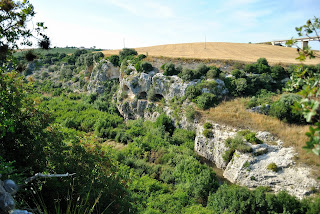 Matera is invaded by
tourists since it has been appointed European Capital of Culture 2019.
Matera is invaded by
tourists since it has been appointed European Capital of Culture 2019.
Matera fully deserves
this significant recognition.
In fact, Matera has
one of the widest Italian cultural heritage.
An example? The
rupestrian churches.
According to Le Chiese Rupestri di Puglia, written by
Franco Dell’Aquila and Aldo Messina, Matera has around 150 rupestrian churches,
which represents the biggest rupestrian heritage between Apulia and Basilicata.
I had red on La Gazzetta del Mezzogiorno, about the
increasing interest of Italian and foreigner tourists about the crypt of “peccato originale”.
This news made me
tremendously curious.
Therefore, the last
week end I set off to Matera to admire it.
Lucia, my partner, has
called ArteZeta (320.5350910;
info@artezeta.it) in order to enquiry about the access.
The customer service
advised that the meeting point was the oil station located 10 km. next Matera
coming from Altamura, on the way towards Potenza.
The ticket costs 8
euros.
The meeting time was
at 5 pm.
We arrived few minutes
earlier.
Some additional tourists were waiting for the guide, who actually arrived at 5 o’clock.
Therefore, after a brief
chat, all get on car and follow the guide.
After few miles,
finally we arrive at a canyon.
Parked the car under an olive tree, 100 metres and we’re in front of the crypt.
“La cripta del peccato originale dates back to between 8th and 9th
century. Therefore, it is the oldest frescos among the rupestrian churches in
Matera. It has been discovered 52 years ago”. The guide says.
“The cripta has been
inhabited for centuries by shepherds, who used to keep in their sheepfold,
light fire and make cheese”. He
continues.
The frescos have been
made during the Longobard
era, when they were settled in Benevento. However, the frescos have evident
Byzantine’s influence.
The aim of these ancient artists who
painted it, was to illustrate to illiterate people some of the most relevant
part of the bible.
We see the spot of the
peccato originale, a snake twisted
around the tree, where the fruit passed by Eva to Adam is a fig rather than an
apple.
The fig can be found
in few other Christian iconography such as the Cappella Sistina’s frescos,
painted by Michelangelo.
So, let’s get back to
the crypt.
The Holy Virgin is
represented with mellow eyes, typical of the Byzantine’s iconography.
Another intriguing
aspect is that some of the Saints have six fingers, just to emphasize the fact
that human beings are imperfect.
I am glad for having
come here to appreciate this amazing place.
We leave the crypt not
before having a brief discussion with the guide, whom I give the address of my
blog.
We leave the crypt,
then we stop after few hundred metres away: we get off the car to visit Dragone, a
local wine maker.
After having entered in this renewed masseria, we are offered few glasses of wine with cheese by a gentle woman.
I don’t like cheese,
but I definetely like good wine.
We homage the
conviviality by buying two bottles of red wine “Il dono”, ten euros each.
Lucia is merry. I’m
fine, ready to drive back home.









No comments:
Post a Comment